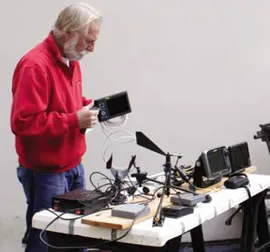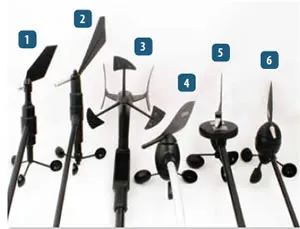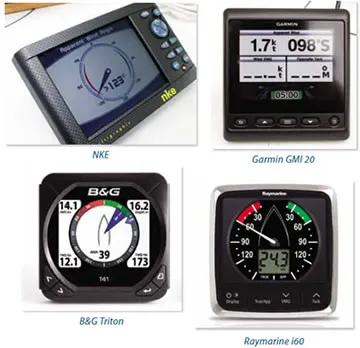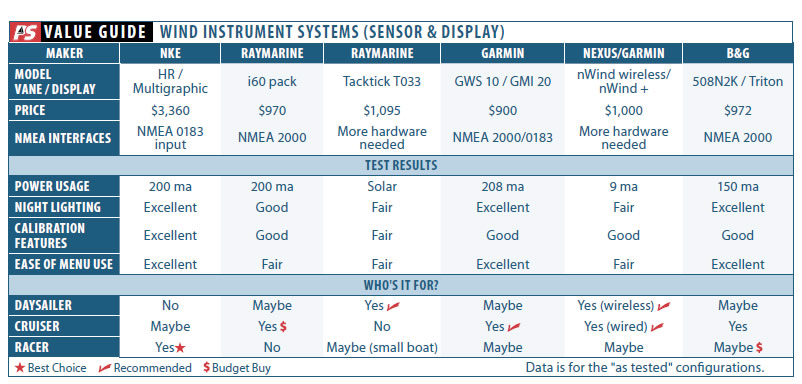
Whether youre contending with the violence of an abroholos or the gentle puff of a zephyr, it helps to have an idea of wind intensity. For the last several months, testers have been closely examining the tools sailors use to measure and display wind information. This article wraps up our review of mechanical vane sensors and displays, focusing specifically on choosing the best combination to meet your needs. Future reports will look at ultrasonic wind sensors, which have no moving parts, and a build-it-yourself wind sensor that uses an Arduino open-source electronics platform.
For the purposes of this report, we are dividing sailboats into three broad categories. The most basic would be the group wed call the daysailer. We think of this boat as having a simple electrical system, if any at all, and basic navigation gear. The boat could be used for occasional overnight stays, but it doesn’t travel far from port and is not typically sailed at night. The second grouping is the cruising sailboat. These have more substantial navigation systems and electrical system capabilities, but by no means, an unlimited power budget. Travel could be for a long weekend or extended cruising for years, and definitely sailing at night, if need be. The last category includes racing boats, whether a club racer looking for a technical edge or a serious ocean racing boat. For this group, we are not so concerned about power limitations and are assuming more comprehensive navigation systems and night travel.
Where your boat falls in these groupings depends on your sailing style and usage. We understand that many boats may have overlaps in these categories.
In our two previous tests (see PS March 2014 and May 2014 online), we looked at the two main components of wind systems independently. For this article, weve priced the sensor and display together, yielding an approximate price for a complete system. Pricing in our Value Guide reflects buying the gear as a system; it is often more if you buy the components separately.
What we tested
This report examines the same products as the previous articles in this series, but as we mentioned, we consider them as package systems this time. From Raymarine, we tested the i60 system pack and the entry-level Tacktick T033 wireless wind system. From Garmin, we included the GWS 10 N2K wind vane coupled with a GMI 20 display, as well as with Garmins 741xs multi-function display (MFD). We also evaluated the Nexus nWind wireless sensor (now sold as the Garmin gWind) with the Nexus nWind+ display. From B&G, we paired the 508 N2K wind vane paired with the Triton display. And lastly, we tested NKEs HR wind vane with the companys Multigraphic display.
How we tested
Testing was done separately on each individual component, then they were combined and tested as a whole. Each system was tested at the minimum configuration needed to perform its function of measuring the wind speed and angle, and displaying the information. In all cases, this was apparent-wind angle and speed. Additional manufacturers hardware can be added to the setups to enhance the capabilities as part of a fully integrated system. For example, the Tacktick and Nexus nWind systems, as tested, had no NMEA interface capability. All of the others were provided with GPS data to test their ability to interpret true wind.
Testers examined a range of performance characteristics. We built a small-scale wind tunnel to provide consistency in wind-speed accuracy testing. Displays were used outside, at night, and with polarized glasses. All wind vanes were mounted to look at rigidity and any issues with removal for winter storage. They were assembled, and disassembled to check ease of installing replacement parts. Installation requirements, cable lengths, system wiring, display night lighting, viewing angles, use with gloves, data damping capabilities, user features, and NMEA interfaces were all explored.

Raymarine i60
Overall, testers liked the analog Raymarine i60 system. It was simple to use, and although the small LCD display was more difficult to read at a distance, the wind direction display was well presented. Sometimes old-school technology does the trick, and this is a good example. This was the only unit that used an electric-mechanical pointer on the display, and testers were impressed with its smooth and responsive motion.
The i60 has decent night lighting with three brightness levels, and the function buttons were large enough that they were easy to use for even gloved users. Access to the setup and menu was not as intuitive as with some of the other systems, but the manual provided clear explanations. Calibration features were good and included a high wind alarm.
The wind sensor was sturdy and responsive, and connecting the wires into the back of the display using pre-installed, push-on connectors was straightforward. Installation documentation was clear and understandable.
Testers felt this was both a good option as a stand-alone system, and for newer Raymarine system owners. The i60 display uses Raymarines SeatalkNG network (NMEA 2000 compatible), and system integration is plug and play.
Bottom line: Although not as feature laden as Raymarines all digital, more expensive i70-based system, the i60 provides all of the basic wind display functionality a sailor needs in a well-conceived package. It is our Budget Buy for the cruising sailor.

Raymarine Tacktick T-033
Raymarines Tacktick T-033 wireless, solar-powered system is ideal for the sailor who wants wind information on a smaller boat without having to supply ships power. Both the Tacktick display and sensor are individually battery powered and charged with built-in solar panels. Testers had no issues with power, even when the system ran continuously for several days with the display night lighting on at its brightest setting at night. At full charge, the system can run for up to 300 hours by day, and seven nights at the brightest backlight setting without recharging. Reducing the back lighting levels substantially reduces battery drain. The wind sensor itself is reasonably sturdy and was responsive in light winds.
According to Raymarine, the display can be mounted up to 35 feet from the masthead. Wireless connections issues may arise if the wind sensors transmitter is shadowed by the mast structure. Testers think these problems usually can be solved by locating the display in a more favorable line of sight location, or mounting the wind sensor slightly offset from the mastheads center line.
Like the other black-graphics LCD displays that PS has tested, there was a tendency for one side or the other to have a steeper viewing angle. The Tacktick display does have a contrast adjustment to help optimize viewing at a particular angle. The displayed data was very easy to see at a distance.
The calibration features are limited to three wind damping levels, and there are no wind-related alarms included in the system. Menu access is fairly intuitive. The function buttons are smaller than the other tested systems and have bezels surrounding them. This made operation with gloves a little more difficult.
Bottom line: Although the Tacktick had fewer capabilities than many other systems tested, it does perform the basic wind presentation information adequately, and it is ideal for the boat with minimal or no electrical infrastructure. We recommend it for small boats or trailer-stored racing boats with basic or no electrical system.
Garmin GWS 10 & GMI 20
This was one of two systems we tested that used a NMEA 2000-based wind sensor. Testers noted that there was more mechanical play in the GWS 10s moving parts than in other sensors. Over time, this could cause some binding of the vane in bouncy conditions. It was also tricky to install the anemometer cups and replacement vanes, requiring some patience to get them on correctly. This may be a contributing factor to some of the reports weve received of Garmin cups and vanes falling off. Testers found that when the cups and vanes were properly installed on the unit we tested, they were very secure and required considerable effort to remove.
The GWS 10 wind sensor also worked well in testing, but at presstime, it was being discontinued and replaced with Garmins new N2K-based gWind system.
We tested the GWS 10 with three different displays: the Garmin GMI 20, the Garmin 741xs MFD (see PS July 2014 online), and the B&G Triton display. We will concentrate on the GMI 20 here.
The NMEA 2000-based, low-profile GMI 20 performed well during testing and is functionally similar in many ways to its counterpart, the B&G Triton display. Because the GMI 20 is designed as an N2K data display unit, its capable of displaying a wide range of vessel-related data. Included is a predefined suite of wind pages, and customizing specialty pages is easy to do. The wind-damping function, which controls the sensitivity of the sensor by adjusting the rate at which wind speed is sampled and averaged, has a range from one to 15; night lighting can be set at one of 20 levels. Menu access is very intuitive, and testers were able to quickly select features and make adjustments. The manual is adequate but painfully brief given the units extensive capabilities.
The display is bright and easily readable even at sharp angles. The function buttons, although smaller than most others, are suitable for glove wearers.
Bottom line: The GMI 20-based wind system is full featured and will satisfy both cruising sailors and the weekend racer. Testers found little to dislike other than the issues with GWS 10 sensor. In our opinion, this system will perform better with the new gWind sensor, which is nearly identical to the nWind sensor that we tested. (Garmin recently purchased Nexus, thus acquiring the brand and the sensor technology.) Although the nWind was a wireless unit, the gWind sensor will be available as either wired or wireless. The wireless sensors will be easier to install, but we would recommend a more bulletproof wired version for long-term cruising.
Garmin/Nexus nWind & NxWind+
The Nexus nWind sensor family has recently been re-branded as the new Garmin gWind, and it appears to be mechanically identical. The primary difference in the new version is that it utilizes a black box (GND 10) to interface to both NMEA 2000 and the existing Nexus network.
The Nexus/Garmin wind sensor is highly regarded by testers. It was the only unit that did not exhibit anemometer speed changes when tipped at an angle (as in the case of a heeling sailboat). The twin-vane design was very responsive, and it appears to be more resistant to bird damage than the others. The mount was well constructed, fairly stiff, and had a clever quick-release system. Similar to the Raymarine Tacktick system, the wind sensor also has a built-in battery and solar panels for charging. Where it differs is that the standalone receiver can be located where it can best pick up the wireless signal. This allows use on much larger vessels.
In the latest version of this system, the Garmin WSI wireless receiver box will connect to one of the Garmin GND 10 black boxs two Nexus ports, which will bridge NMEA 2000 data to both the Nexus display and the N2K network, allowing wind data to be shown on any NMEA 2000 display that accepts wind data (as most do). This would include multifunction displays like the Garmin 741xs. For testing purposes, the Nexus NxWind+ display was connected directly to the WSI wireless receiver.
The NxWind+ black-graphics LCD uses a split screen to show data. The right side is used for analog wind direction with a pie-chart representation of true-wind direction and a needle pointer for apparent wind. The screens left side is for large-character numeric data. The Wind+ had solid calibration features, but menu access was a bit awkward, and testers needed the manual to make any setup changes. The documentation was well written, making this an easier task.
The display was viewable at a distance, but like the Tacktick unit, it was harder to see from one side (the right). The function buttons were glove-wearer suitable and had an audible click when pressed.
Bottom line: One of the notable features of this configuration is the extremely low power consumption of 9 milliamps. The new gWind with the GND 10 black box and the same display will use a miserly 37 milliamps. Where power is a consideration and a wide range of sailing features are needed, this is a good choice. If the new gWind package lives up to expectations, we anticipate that it will climb the ranks.
B&G Triton
The Triton paired with a B&G 508 wind sensor was one of the better performing combinations in our test. This is effectively the entry-level product for B&G wind systems, a long-time favorite among racing sailors.
The NMEA 2000 wind sensor was well constructed and sensitive. The only needed improvement we found was removing some of the play in the quick-release mount that connects the vane arm to the mast. This was one of the two sensors we tested that had an adjustment for vane balancing; the other was the NKE HR.
The Triton has conceptual similarities to the GMI 20 in that both are NMEA 2000 display devices, but beyond that, they vary considerably. The Garmin has a strong suite of wind pages, but its more generalized and can display a broader range of NMEA data. The Triton has more comprehensive sailing-related capabilities and less general data display abilities. The Triton has built-in sailing-related autopilot control (with select Simrad and B&G autopilots). It also has a larger selection of screen-display configurations. The menus are intuitive, and the documentation was understandable and complete.
The display is viewable at a distance and was the brightest of the displays tested. The function buttons were large and glove-wearer suitable.
Bottom line: The Triton display and B&G wind sensor are an excellent combination. They offer the most extensive set of sailing features of all the units tested outside of NKEs Multigraphic-based system. The Triton would be more than suitable for the cruiser, excellent for the local racer, and is not all that far from being usable at a professional racing level. This is our recommended unit for those opting for a B&G/Simrad autopilot.
NKE Multigraphic & HR
Apart from the price, it was hard to find something to complain about with the NKE Multigraphic display and HR sensor system. The HR wind sensor was the most rigid and well built of the lot. The all anodized-aluminum construction, composite wind vane, and sturdy stainless-steel mount made it a stand out. It was very responsive, even in light winds.
The Multigraphic display was likewise impressive. Like the Triton, its a combo unit that has built-in autopilot control, and on top of that, it has AIS displays and alarms. The Multigraphic was the largest display tested (5.7-inch diagonal) with five skins to choose from (page/color configurations). Setup wizards help with calibration, and the race timer had visual and audible signaling. The menus are easy to navigate, and given its wide capabilities, the system was easy to learn and use.
The display is viewable at a distance and was the brightest of the displays tested. The function buttons were large and glove-wearer suitable.
Bottom line: This system is for the enthusiastic club racer and certainly would be capable in the professional racing arena. It also would be suitable for the cruising sailor who wants the best and can afford the higher pricing. Testers found the system to be easy to use, and its features are most impressive.
Conclusions
Each of these systems did a good job of displaying basic wind data. Surprisingly, the pricing for all these tested systems, excluding the NKE system, were within a couple hundred of dollars of each other. Testers did have some favorites.
The NKE wind sensor was the best overall wind sensor tested, but the Nexus/Garmin twin-vane, propeller-style anemometer was a close second at less than half the price. For the sailing enthusiast, the Triton display was hard to beat in both price and performance. The GMI 20 was also a good option, especially if more generalized information was desired at the helm. In the end, testers tapped the B&G Triton display and the new Garmin gWind sensor as the optimum mix-and-match system, but the advantages of staying within a single system-including easier installation and simplified post-purchase support-compel us to advise most sailors who need to replace both a masthead sensor and a display to stick with one brand.



































A thousand bucks to measure wind speed? Isn’t there a $90 solution? Or $50?